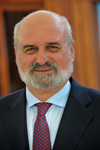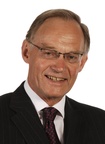The right size for the European Neurology Congress
by Richard Hughes, EFNS President
The British geneticist JBS Haldane began his 1928 essay “On being the right size” by illustrating the impossibility of fairy tale giants. He wrote “consider a giant man sixty feet high—about the height of Giant Pope and Giant Pagan in the illustrated Pilgrim’s Progress of my childhood. These monsters were not only ten times as high as Christian, but ten times as wide and ten times as thick, so that their total weight was a thousand times his, or about eighty to ninety tons. Unfortunately the cross sections of their bones were only a hundred times those of Christian, so that every square inch of giant bone had to support ten times the weight borne by a square inch of human bone. As the human thigh-bone breaks under about ten times the human weight, Pope and Pagan would have broken their thighs every time they took a step. This was doubtless why they were sitting down in the picture I remember. But it lessens one’s respect for Christian and Jack the Giant Killer.”
If giants are too large, should we worry about the size of our European neurology congresses when the EFNS joins up with the European Neurological Society (ENS)? Following the EFNS Congress in Stockholm from September 8th to 11th 2012 and the World Congress of Neurology which we will co-host with the Austrians in Vienna from September 21st to 26th 2013, we will hold a joint congress of the EFNS and ENS in Istanbul in June 2014. The new European Academy of Neurology will be created in Istanbul and will hold annual congresses from 2015 onwards. Our expectation is that the attendance will rise from the 3000 or 5000 participants in the current separate ENS and EFNS congresses to 7000 or more when we have a single annual congress. This was the number of delegates at the successful and enjoyable World Congress of Neurology in London in 2001. Some international medical and scientific congresses commonly host 10,000 delegates and others reach the more daunting and probably undesirable totals of 30,000.
Larger congresses should be more cost effective. This will be increasingly important during financial hardship especially when support from pharmaceutical industry is dwindling. Larger congresses ensure that special interest groups are represented in sufficient numbers. This enables meaningful dialogue between experts in settings where less senior investigators and practitioners can benefit from their expertise. Larger congresses provide for the interests of the general neurologist and the sub- (or super-) specialist which smaller special interest meetings can never do. Larger congresses require larger congress centres. Sadly this limits the number of venues suitable for our needs. Fortunately Europe is well endowed with centres which can cope with the demands of giant neurology congresses.
Richard Hughes is Professor of Neurology in London, UK and President of the EFNS
 Comment by Zohar Argov
Comment by Zohar Argov
Professor Hughes, EFNS President, opened a very important discussion issue: how should we handle the expected large European neurology congress? I would like to share with you some of my personal thoughts (they do not represent any official statement of the ENS).
Should we continue with the large size general neurology congress when so many special interest groups and neurology sub specialties run focused meetings? I strongly favor the continuation of such congresses. I have the impression that two alarming processes take place in European neurology. The first is that residents turn to sub specialties too early in their career. Residents can indeed be attracted to a special area (personal disclosure: I was interested in neuromuscular disorders, my field of specialty today, already as a senior medical student) but should be exposed to developments in other fields, especially those that are not well represented in their place of training. Thus, I feel that residents should in principle attend only general neurology congresses unless they have a special work to present in a sub specialty meeting. The second process relates to senior neurologists who (especially in larger institutes) prefer to concentrate on their focused area of interest and as a result contribute less of their cumulative clinical experience to the handling of the patient with a neurological disorder outside their field. The ‘outsider’s view’ with a different perspective is lost. General neurology congresses can help bringing out some exposure to different views of controversial issues. One should of course also note that general neurology congresses should be used to deliver continuous medical education to neurologists who are in more isolated practices.
This is the main issue that faces us in planning a large congress: how to prepare a format that will suit all these needs? If we run a 7,000-10,000 participant congress – can we prepare a format that will bring the different needs together? I think we do not want simply to have a general umbrella of many different sub specialties meetings. It will definitely save money and the current trend is toward limiting the ability of the industry to support attendees of congresses. But we should think about reformatting the meeting.
Here are some suggestions of mine, which will probably not be accepted by everyone:
1. Mix some topics together in the oral and poster presentations. This is especially true for the general neurology topics.
2. Mix the teaching lectures and the original presentations in a special topic to one session. This will bring the experienced speakers and the young presenters together.
3. Increase the number of sessions devoted to controversies in neurology, especially those related to therapy.
4. Allow more time in the oral presentation to questions and comments. I sometimes have the impression that true discussion is prevented or seriously cut by short ‘post presentation’ time. It will of course decrease the number of oral presentations, but scientific exchange of ideas will only gain from such a move.
5. Poster presentations should be discussed in small groups by a leader in the field. These sessions are sometimes limited by poster area size but with current technology of head phones we can overcome the crowd noise. This will also give the poster presenters the feeling that their work is noticed and not just hanged there in the large room.
6. “Meet the professor” sessions should be more frequent, but the expert rather than the attendees should be responsible for bringing illustrative cases. Clearly inexperienced people are shy of bringing their cases, but one can overcome this by opening a time slot after a course for general questions in the field. For instance, in the last World Congress of Neurology the final half an hours of the Muscle Course was devoted to any question in the neuromuscular field brought to the attention of the 4 speakers (even if not in their area of super specialty). It led to a very vivid and successful discussion.
I am sure that there are many more suggestions out there and the Forum could be used to bring them to the attention of the committees who will actually have to plan and run the program of the new European Academy of Neurology big congress.
Zohar Argov is Professor of Neurology at the Hadassah Medical Association in Jerusalem, Israel and President of the European Neurological Society (ENS)




